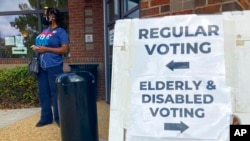When midterm elections get under way next month, voters in several Republican-controlled states will be casting their ballots in congressional districts with borders that courts have rejected.
In Alabama, Georgia, Louisiana and Ohio, the congressional maps were drawn by Republican legislators in the aftermath of the 2020 census. Judges later ruled that the maps were illegally drawn or likely to be proven illegal at trial.
But the U.S. Supreme Court, and other federal courts following its precedent, have allowed the rejected maps to be used for this election, rejecting proposals to make them fairer.
Their rationale? A little-known legal concept that says judges should refrain from changing voting rules close to an election because doing so can lead to chaos and confusion and keep voters away from the polls.
Known as the "Purcell principle," the concept takes its name from a 2006 Supreme Court case called Purcell v. Gonzalez. The case involved a legal challenge to Arizona's voter ID requirements. It was a midterm year, and the Supreme Court dismissed the challenge.
'Bedrock tenet'
In the 16 years since the Arizona ruling, the "Purcell principle" has become what Supreme Court Associate Justice Brett Kavanaugh has called a "bedrock tenet of election law."
“When an election is close at hand, the rules of the road must be clear and settled," Kavanaugh wrote in February, explaining his decision to allow Alabama's Republican-backed congressional map to take effect even though it had been rejected by a three-judge panel. "Late judicial tinkering with election laws can lead to disruption and to unanticipated and unfair consequences for candidates, political parties and voters, among others."
That means judges should be wary of issuing orders that change voting rules close to an election, and so they have. In 2020, the Supreme Court repeatedly blocked changes that sought to make it easier for voters to cast their ballots during the deadly COVID-19 pandemic.
Critics say this amounts to putting the administration of elections ahead of safeguarding the right to vote.
"I think the balance they've chosen is out of whack," said Dan Vicuna, the national redistricting manager for the watchdog Common Cause.
Rick Hasen, a University of California-Los Angeles election law expert who coined the term "Purcell principle" in 2016, has argued that the Supreme Court should "rein in" the doctrine.
Republicans have stood by their maps.
Hans von Spakovsky, a former county election official now with the conservative Heritage Foundation, said the Purcell principle is a "good rule" with an important purpose.
"Anyone who's got a problem with [an election] law or regulation has plenty of time before an election to file a lawsuit," von Spakovsky, manager of the Heritage Foundation's Election Law Reform Initiative, said.
Districts redrawn each decade
The disputed congressional maps in the four states are considered "gerrymandered," a portmanteau with origins in early 19th-century American politics.
Every 10 years, following a constitutionally mandated census, U.S. states redraw their congressional and state legislative maps to reflect changes in their electorate.
Gerrymandering occurs when voting district maps are redrawn for political gain, for example by packing opposition party voters into one district so as to reduce their influence in others.
The practice is legal in most states, and both Democrats and Republicans engage in it. But when a map is flagrantly drawn to favor one group over another, it can run afoul of state and federal laws.
The Voting Rights Act of 1965 prohibits racial discrimination in voting. Under the law, voters can seek judicial relief if they believe a voting practice or procedure such as a new political map "abridges" their right to vote.
Under the Voting Rights Act, challengers can also bring claims of "vote dilution." Vote dilution occurs when minority voters cannot elect the candidate of their choice because of gerrymandering. This was part of the claim in the legal challenge against the congressional maps in Alabama, Georgia and Louisiana.
Former procedure
Before Purcell, aggrieved voters could sue for judicial relief and courts did not dismiss the challenge simply because an election was close at hand.
But that changed with Purcell, according to David Gans, director of the human rights, civil rights and citizenship program at the Constitutional Accountability Center.
"Purcell has made it incredibly difficult for courts to provide relief when state governments violate the right to vote, when they put in place discriminatory maps that dilute the vote for communities of color," Gans said.
Consider what happened in Georgia.
In December, civil rights groups filed lawsuits against the state's new political redistricting maps that appear designed to give Republicans an additional House seat even though the state's electorate has become increasingly Democratic.
Then in March, with the state's primary elections under two months away, U.S. District Judge Steve Jones, citing the Purcell principle, ruled that the challenged maps could be used even though he found that they included boundaries that violated the Voting Rights Act.
"Changes to the redistricting map at this point in the 2022 election schedule are likely to substantially disrupt the election process," Jones wrote.
In Alabama and Louisiana, federal courts found that the two Southern states' redistricting maps violated the Voting Rights Act, only to be overruled by the Supreme Court.
High court's rulings
The Supreme Court, dominated by six conservative justices appointed by Republican presidents, has applied the Purcell doctrine "in a way that's mostly friendly to Republicans," Vicuna said, but that has not always been the case.
In March, for example, the high court refused to overturn a map drawn by the North Carolina Supreme Court over the objection of Republican lawmakers who wanted to use their own map.
In addition, the high court has rejected Republican challenges to redistricting maps drawn by Pennsylvania and Wisconsin, though not on the grounds of Purcell.
Election law experts say that while the likelihood of voter confusion can be a strong argument against making last-minute changes in voting procedures, it should not be the sole factor.
"One of the reasons the court has gone awry is that it's not looked at the sort of traditional factors that apply when there's a request for emergency relief," Gans said. "Purcell has essentially replaced that sort of more careful fact-specific analysis with this across-the-board hostility to protecting voting rights."











